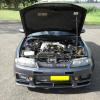EPA - running no blow off valve at all - is this legal?
Announcements
-
Similar Content
-
Latest Posts
-
@Murray_Calavera If I were an expert I wouldn't be in here looking for assistance. I am extremely computer literate, have above average understanding on how things should be working and how they should tie together. If I need to go to a professional tuner so be it, but I'd much rather learn and do things myself even if it means looking for some guidance along the way and blowing up a few engines. @GTSBoy I was hoping it would be as simple as a large vacuum leak somewhere but I'm unable to find anything, all lines seem to be well capped or going where they need to be, and when removed there is vacuum felt on the tube. It would be odd for the Haltech built in MAP to be faulty, the GTT tune I imported had it enabled from the start, I incorrectly assumed it was reading a signal from the stock MAP, but that doesn't exist. After running a vacuum hose to the ECU the signal doesn't change more than 0.2 in either direction. I'll probably upload a video of my settings tomorrow, as it stands I'm able to daily drive, but getting stuttering when giving it gas from idle, so pulling away from lights is a slow process of revving it up and feathering the clutch until its moving, then it will accelerate fine. It sounds like I need to get to the bottom of the manifold pressure issue, but the ignition timing section is most intimidating to me and will probably let a pro do that part. Tomorrow I'll try a different vacuum line to T off of, with any luck I selected one that was already bypassed during the DBW swap. @feartherb26 I do have +T in the works but wanted to wait until Spring to start with that swap since this is my good winter AWD vehicle. When removing the butterfly, did it leave a bunch of holes in the manifold that you needed to plug? I thought about removing it but assumed it would be a mess. I notice no difference when capping the vacuum line to it or letting it do its thing. This whole thing has convinced me to just get a forward facing manifold when the time comes though.
-
Update: tested my spark plugs that are supposed to be 5ohms with a 10% deviation and one gave me a 0 ohms reading and the rest were 3.9ohm<, so one bad and the others on their way out.
-
9" wheels are a little too wide for a RWD 32. They can fit. People have put R33 GTR wheels on 32s for years and years. But they are a very tight squeeze. This has been known for about 30 years. As I said - there is no difference between a 17 and an 18 in terms of what will fit. The rolling diameter needs to stay about the same as stock - not very much larger. If you increase that, you will start to have problems. If you increae rolling diamater at the same time as yo increase width, you will have problems earlier. as 9" wheels are pushing the boundaries already, you would need to be careful with tyre choice. I would put 8.5s on the front of mine, but would expect problems with 9s.
-
By Dose Pipe Sutututu · Posted
post up screen shots of your injector tables -
By joshuaho96 · Posted
Diagnostic flow for a code 21 says check signal at the ECU pins, on a voltmeter of some kind it should read 0.1V at idle, 0.12V cranking, 0.15-0.25V at 2000 rpm. Check each coil such that +1, -3 is infinite or very high resistance, -3, +2 should do the same. (-1, +3), (+3, -2), (+1, -2), and (-1, +2) should all be somewhere between 0 ohms and high resistance. If you trace the path from the coil pin all the way back to the ECU in the diagram the resistance you measure at the coil vs connected to the harness should be pretty much the same.
-




Recommended Posts
Create an account or sign in to comment
You need to be a member in order to leave a comment
Create an account
Sign up for a new account in our community. It's easy!
Register a new accountSign in
Already have an account? Sign in here.
Sign In Now